The multifaceted interactions between pathogens and host ESCRT machinery
- PMID: 37141275
- PMCID: PMC10159163
- DOI: 10.1371/journal.ppat.1011344
The multifaceted interactions between pathogens and host ESCRT machinery
Abstract
The Endosomal Sorting Complex Required for Transport (ESCRT) machinery consists of multiple protein complexes that coordinate vesicle budding away from the host cytosol. ESCRTs function in many fundamental cellular processes including the biogenesis of multivesicular bodies and exosomes, membrane repair and restoration, and cell abscission during cytokinesis. Work over the past 2 decades has shown that a diverse cohort of viruses critically rely upon host ESCRT machinery for virus replication and envelopment. More recent studies reported that intracellular bacteria and the intracellular parasite Toxoplasma gondii benefit from, antagonize, or exploit host ESCRT machinery to preserve their intracellular niche, gain resources, or egress from infected cells. Here, we review how intracellular pathogens interact with the ESCRT machinery of their hosts, highlighting the variety of strategies they use to bind ESCRT complexes using short linear amino acid motifs like those used by ESCRTs to sequentially assemble on target membranes. Future work exposing new mechanisms of this molecular mimicry will yield novel insight of how pathogens exploit host ESCRT machinery and how ESCRTs facilitate key cellular processes.
Copyright: © 2023 Rivera-Cuevas, Carruthers. This is an open access article distributed under the terms of the Creative Commons Attribution License, which permits unrestricted use, distribution, and reproduction in any medium, provided the original author and source are credited.
Conflict of interest statement
The authors have declared that no competing interests exist.
Figures
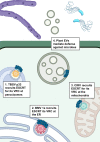
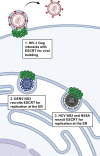
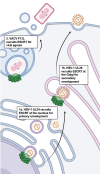
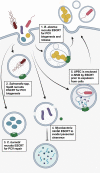
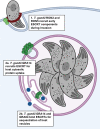
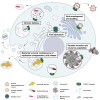
Similar articles
-
Hepatitis C Virus Proteins Interact with the Endosomal Sorting Complex Required for Transport (ESCRT) Machinery via Ubiquitination To Facilitate Viral Envelopment.mBio. 2016 Nov 1;7(6):e01456-16. doi: 10.1128/mBio.01456-16. mBio. 2016. PMID: 27803188 Free PMC article.
-
The many functions of ESCRTs.Nat Rev Mol Cell Biol. 2020 Jan;21(1):25-42. doi: 10.1038/s41580-019-0177-4. Epub 2019 Nov 8. Nat Rev Mol Cell Biol. 2020. PMID: 31705132 Review.
-
Toxoplasma gondii exploits the host ESCRT machinery for parasite uptake of host cytosolic proteins.PLoS Pathog. 2021 Dec 13;17(12):e1010138. doi: 10.1371/journal.ppat.1010138. eCollection 2021 Dec. PLoS Pathog. 2021. PMID: 34898650 Free PMC article.
-
The regulation of Endosomal Sorting Complex Required for Transport and accessory proteins in multivesicular body sorting and enveloped viral budding - An overview.Int J Biol Macromol. 2019 Apr 15;127:1-11. doi: 10.1016/j.ijbiomac.2019.01.015. Epub 2019 Jan 4. Int J Biol Macromol. 2019. PMID: 30615963 Review.
-
Growing functions of the ESCRT machinery in cell biology and viral replication.Biochem Soc Trans. 2017 Jun 15;45(3):613-634. doi: 10.1042/BST20160479. Biochem Soc Trans. 2017. PMID: 28620025 Review.
Cited by
-
Selective host autophagy is induced during the intracellular parasite Toxoplasma gondii infection controlling amino acid levels.mSphere. 2024 Jul 30;9(7):e0036924. doi: 10.1128/msphere.00369-24. Epub 2024 Jul 9. mSphere. 2024. PMID: 38980070 Free PMC article.
-
NEDD4 family ubiquitin ligase AIP4 interacts with Alix to enable HBV naked capsid egress in an Alix ubiquitination-independent manner.PLoS Pathog. 2024 Sep 11;20(9):e1012485. doi: 10.1371/journal.ppat.1012485. eCollection 2024 Sep. PLoS Pathog. 2024. PMID: 39259704 Free PMC article.
-
Exosome-Mediated Antigen Delivery: Unveiling Novel Strategies in Viral Infection Control and Vaccine Design.Vaccines (Basel). 2024 Mar 7;12(3):280. doi: 10.3390/vaccines12030280. Vaccines (Basel). 2024. PMID: 38543914 Free PMC article. Review.
-
Human cytomegalovirus deploys molecular mimicry to recruit VPS4A to sites of virus assembly.PLoS Pathog. 2024 Jun 20;20(6):e1012300. doi: 10.1371/journal.ppat.1012300. eCollection 2024 Jun. PLoS Pathog. 2024. PMID: 38900818 Free PMC article.
-
Exploring Information Exchange between Thesium chinense and Its Host Prunella vulgaris through Joint Transcriptomic and Metabolomic Analysis.Plants (Basel). 2024 Mar 12;13(6):804. doi: 10.3390/plants13060804. Plants (Basel). 2024. PMID: 38592814 Free PMC article.
References
Publication types
MeSH terms
Substances
Grants and funding
LinkOut - more resources
Full Text Sources
Miscellaneous

